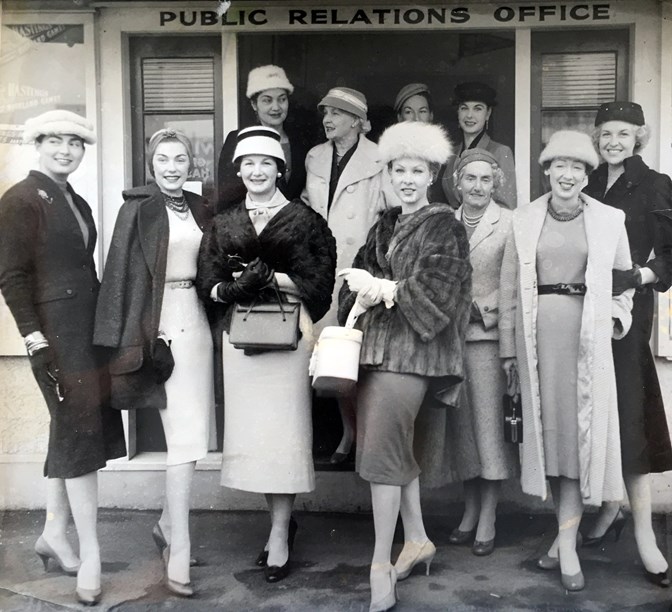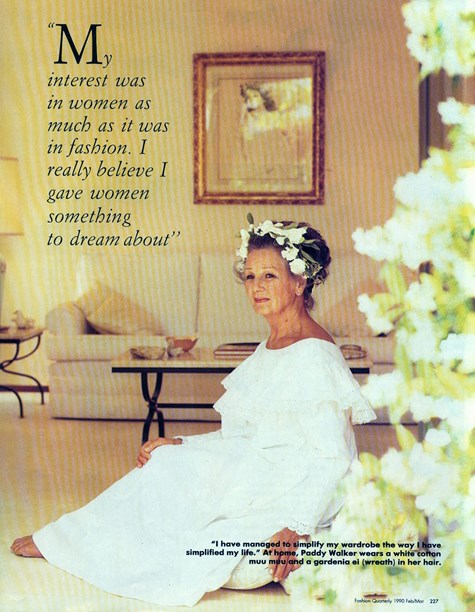Stories
Paddy Walker
1916-2015

"Fashion affects simply everything: architecture, gardens, food, cars, language, music, education … all of those and everything else - is subject to fashion!"
Edwina Diana Patricia Halliday, Paddy as she was known to all, was born in Pago Pago, American Samoa - the eldest of six children and with a lineage which equated to royalty in the Pacific: born into the Seumanutafa family, Chief of Apia, Western Samoa which subsequently provided her with the title - Eleitino.

Paddy Walker in June 1957.
Paddy was a gifted pianist and composer. It was that gift that formed her future when, age 10, she arrived at St Cuthbert's boarding school from Samoa with only a suitcase and a ukulele. And it was her background, though one of privilege, that also provided her with a resilience which would be the basis for a prestigious career. The paths she followed may have been divergent, but the links to her Polynesian heritage were the foundation. Being one of Auckland’s beauties was a clever cover-up for a woman of indomitable will-power. So it should be no surprise that this was a platform which led her to a luminous career in fashion - albeit by necessity as opposed to choice.
She met her husband Bill at a family party. He was working for Yock and Co as a travelling salesman and his talent for marketing merchandise was legendary. But until the day Bill died, Paddy always put out the clothes he was to wear - the fashion instincts were definitely on her side of the twosome.
During the Second World War, Bill was sent to the Solomon Islands. He returned with tuberculosis and spent five years in hospital - firstly in Auckland and then in Hanmer Springs Sanatorium. With two young children to support, Paddy quickly realised she had to find work. A keen interest in clothes gave her the courage to take herself into Hays Department Store and meet with Sir James Hay – the owner – where she informed him that she wished to work in fashion. While her daughter Michal McKay recalls that she had a wardrobe that any little girl would covet, all made by her mother, Paddy’s only work experience had been at St Cuthberts where she had taught music and eurhythmics. Sir James, like so many since, succumbed to her charm and she became the store’s first fashion coordinator. She worked with the buyers to spearhead a move toward the more directional fashion for which the store became renowned. She also took on the task of organising the seasonal fashion parades.
Before Paddy Walker arrived on the scene, fashion parades were very sedate affairs with the models simply promenading to show off the garment. Paddy changed all that, taking the rhythm, structure and musical expression which is central to eurhythmics, and applying it to the creation of dynamic choreographed fashion parades. The shows she organised and presented were innovative, carefully planned and often themed especially for the look of the season or around a colour. They became "must-see" occasions for Christchurch’s fashionable women. It was the beginning of a successful career working in the world of fashion. During the Royal Tour in 1953-54 she worked as the fashion coordinator for the Canterbury manufacturers, Lane Walker & Rudkin, producing an outstanding show for the Royal entourage, including Her Majesty Queen Elizabeth II.
It is her work in Auckland for which Paddy is best remembered. Following a transfer to Auckland in 1952, she took on the role of fashion coordinator at Milne & Choyce department store and immediately made her mark there. With her team of beautiful models she staged lively, standing-room-only fashion productions that set the tills into overdrive. Alive with music and movement, the shows sold every day for the whole week of the seasonal launch. At Milne’s she worked with their in-house couturier, Bruce Papas, who remembers her fondly. She always wanted to wear something from his collection on stage as she compered the parades.
It was during her time with Milne's she met Bernard Leser, who had become the publisher of Vogue Australia and was a lifelong friend of John Milne's. Paddy and Bernie became firm friends and throughout Bernie's illustrious career as the Managing Director of Conde Nast in London and subsequently as President of the Conde Nast empire in New York, they remained in close contact. Paddy’s daughter Michal regards him as her mentor - his interest in her career was a spin-off of his deep friendship with Paddy.
As her reputation grew and Paddy began working with some of the other top designers in the city including Colin Cole ("a very dear friend"), Emma Knuckey and Barry McDonnell. By this stage she had become more of a fashion impresario, working in a freelance capacity to produce their shows, as well as multiple spectaculars. Her productions for charitable events were just as successful, garnering huge audiences and consequent financial rewards.

Paddy Walker (3rd from left) during the 1957 National Fashion Show. Also pictured are Else van den Muysenbergh, Shirley Gissing, Nancy Harry and Mira Szasy.
In 1963 during the second Royal Tour, Paddy mounted a major event, a spectacular showcase for the New Zealand Wool Board. This event was attended by the Queen who personally presented the Wool Design Award to Auckland designer Barbara Herrick of Babs Radon. Paddy and Barbara became firm friends and in 1964 travelled to India together at the invitation of the Indian Trade Council. The New Zealand Herald reported that they "formed a miniature trade mission". As fashion experts they were charged with selecting dress and upholstery fabrics that would be suitable for local manufacturing. These would then be presented in a special promotion in the Indian Pavilion at the International Trade Fair that was to take place in Wellington in August that same year.
Many well known models of the era started off as one of Paddy's protégés, including Maysie Bestall Cohen who remembers her with fondness and admiration. "She was certainly an icon in her day and a pioneer of choreographed fashion events. I remember modelling for her when the 246 department store was celebrating their fashion launches – such an honour – I could hardly believe my luck. She loved using dancers (I was not one of them!) as they could remember all the steps and smile all the time."

Paddy Walker (centre) rehearsing models for a fashion parade in 1957.
Paddy's ability to smile, charm and coerce even the most reluctant was legendary. Her power of persuasion ignited by her passion was a force to be reckoned with. Her productions for charitable events and her work in support of community funding and activities was the segue to her next career step, providing an awareness and need in an area which finally motivated her to move into it.
Fashion as a career ultimately took a sideline due to her strong ties to her Polynesian heritage. In the 1970s, when Auckland became a city of choice for Pacific Islanders wanting to provide a better life and education for their families, it became apparent to Paddy that much was needed in the way of support and infrastructure to help these migrants make the most of their new life. So she stood for Auckland City Council and from 1973 she served two terms as a Councillor. She was the first female Councillor of Pacific heritage - her brief being Parks and Reserves, and multicultural consultation. As Vice President of the National Council of Women, her focus shifted to major efforts supporting Pacific women living in New Zealand.
Paddy became the founding president of PACIFICA NZ in 1974, and she set up the Pacific Island Youth Leadership Trust which provided bursaries for students from the Pacific Islands. This led to appointments to the New Zealand Social Development Council and to the Māori and South Pacific Arts Council. Paddy could be described as one of the original Pacifists. She joined the Pan Pacific South East Asian Women's Association in 1975, which became her springboard to promote the cause, participating in 20 international conferences including International Women’s Year. For her groundbreaking work she was awarded an OBE in 1976.
Widowed and retired she went to live in Rarotonga in 1989. Here she established a second language learning programme for the Cook Islands Ministry of Education, instigated reading activities for children to promote literacy, and taught teacher trainees how to incorporate music, speech and drama into teaching.

Paddy Walker photographed for Fashion Quarterly magazine, 1990. Image © Fashion Quarterly.
She was appointed an International Peace Ambassador and in 2009 was nominated for a Nobel Peace Prize. In 2014 at the age of 97, Paddy Walker was honoured by the Auckland University’s Faculty of Education with a Distinguished Fellow Award – for services to Pacific education - the first-ever Pacific woman of non academic background to be so honoured. In the induction ceremony she was described as "a wayfarer and navigator in the field of transformative education".
She returned to live in Auckland later that year, and left this world with her lasting legacy in July 2015. One of the rooms at the Pioneer Women’s Hall in Auckland is named in her honour.
Text by Michal McKay. Banner image of Paddy Walker (left) and Barbara Penberthy in India, 1964.
Last published May 2018.